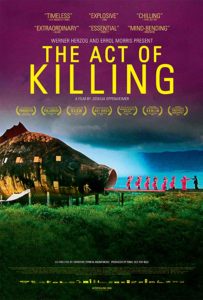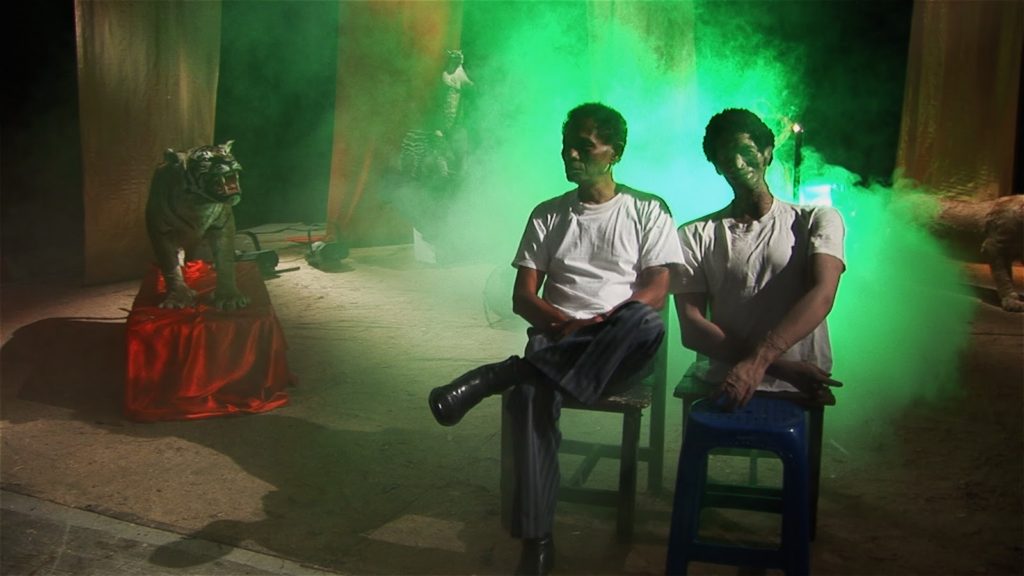Mass Murderers and Their Hollywood Dreams
DIRECTED BY JOSHUA OPPENHEIMER/2013 (U.S. Theatrical Release)

Joshua Oppenheimer doesn’t mislead in the opening of The Act of Killing, his documentary about genocide in Indonesia. The film opens not with archival footage of atrocities or interviews with victims, but with a surreal dance number in front of a waterfall. “Peace! Happiness! Smiles! Don’t let the camera catch you looking bad!”, the dancers are directed from offscreen, until “cut” is called and it becomes clear how miserably cold the dancers are.
The gap between peaceful, smiling exteriors and the truth that lies underneath is a central theme of this film. Oppenheimer has tackled a subject unfamiliar to most Americans – the extermination of over a million Communists (and other convenient victims, including ethnic Chinese) in Indonesia in the mid to late 60s. The government used criminals – paramilitary groups, to put it more delicately – as death squads. There’s never been any public reckoning for these atrocities, and many of the perpetrators are public figures in Indonesia. The fact that there is no shame attached to having been involved in the killings gave Oppenheimer a unique opportunity. He not only interviewed former death squad leaders but gave them the chance to tell their stories through cinema, in any way they chose. The result is almost indescribable. The Act of Killing is at turns horrifying, nightmarish, heartbreaking and even funny. It’s a journey into the heart of darkness that never lets us forget what these people have done, and yet keeps them recognizably human.
While evil wears a human face in this film, the range of personalities among the killers is striking and fascinating. There’s Safit Pardede, a vicious thug, shown extorting money from Chinese shop owners and bragging about raping young girls; Adi Zulkadry, a rational, dispassionate middle class family man, insisting he’s never suffered depression or guilt as a result of what he’s done; Ibrahim Sinik, a newspaper publisher who didn’t have to carry out the killings (“Why would I do such grunt work?”) but boasts of having lied in print to make the public hate the victims of the genocide. But most of all, at the center of the film, are two men: Anwar Congo and Herman Koto. Anwar is a legend in Indonesia; a thin, graceful, charismatic man who was personally responsible for killing hundreds if not thousands. He’s revered in Indonesia as a hero. In a talk show interview included in the movie he’s praised for having developed a “new, more efficient system for exterminating Communists”. Anwar is a fan of American films – Marlon Brando, Al Pacino, John Wayne – with very specific ideas of how he wants to tell his story. He has the spirit of an auteur and his cinematic vision shaped his killing, as well. In fact, that “more efficient system” Anwar relied on was strangling with wire, inspired by his love of gangster films. “Every genre has its own method,” he says.
Herman is Anwar’s loyal sidekick. If he was not a leader in a violent paramilitary organization it would be easy to see him solely as a comic figure. He spends many of the films fantasy sequences in garish drag, something he seems to enjoy immensely. His brief run for parliament is undeniably funny, with him practicing public speaking while listening to Obama, yet needing to be prompted when he tries to deliver a memorized speech (“What’s the first sentence?” he asks an assistant. “I’m Herman,” is the reply).

It would be possible to lose sight of what these men have done, seeing the aging Adi and Anwar fishing together, watching Herman with his young daughter – but Oppenheimer keeps returning us to their horrific stories, told from the preening but exacting perspectives of the killers. Death is stylized into gangster films, westerns, musical numbers. One extended reenactment, the destruction of an entire village, is told straight and even the government official who has come to participate and cheer on the proceedings is taken aback by what he sees: “What we just shot? I felt terrible.”
Oppenheimer does include one victim’s story, and it is gut wrenching to watch. Anwar’s neighbor, Suryono, is helping with the film, and one day on set tells a story beginning with “There was a Chinese shopkeeper.” At first cautiously, and then with greater and greater abandon, Suryono confesses that the shopkeeper was his stepfather who had raised him since he was a baby. Always laughing and smiling, careful to say that he’s not criticizing the killers, Suryono tells of his stepfather being kidnapped and killed when he was a young boy. There is a moment when his face altars, when pain and anger manifest briefly, and then it’s back to “Peace! Happiness! Smiles!” When Suryono follows up this story by playing a murder victim in a reenactment, it is with a potency that few actors could surpass.
In telling a piece of one country’s story, profiling a handful of murderers, Oppenheimer has opened the door on countless difficult questions. The role of art in shaping Anwar’s imagination is disturbing, to say the least. The way that governments try to both exploit and distance themselves from violence is demonstrated again and again. Adi, in particular, is a master of rationalizing evil. “The key,” he says, “is to find a way to not feel guilty; to find the right excuse.” For him, it’s simple: “War crimes are defined by the winners. I’m a winner, so I can make my own definitions.” And always in The Act of Killing there is the queasy sense that much of the country of Indonesia is making its own definitions, pretending that the wounds of the past have healed and all is well.
Unlike Adi, Anwar is haunted. There is little chance that he will receive justice for his crimes, but he is tormented by nightmares, and the reenactments begin to bring memories back in ways that are increasingly painful. The boast of all of these men is that they are “gangsters” and “free men”, but Anwar is becoming less and less free before our eyes. Early in the film he stands on a site where he’d tortured and killed, and does a relaxed cha cha as he remembers the past. In the same spot, near the end of the documentary, he retches as he tries to describe what happened there.
By allowing death squad leaders to tell their own stories, to cinematically glory in their crimes, Joshua Oppenheimer has exposed them for the monsters they really are (a danger that the always calculating Adi recognizes and warns against in the film). It’s a masterful, unprecedented accomplishment, and as important a film as I have ever seen. There is a passage of scripture in which false prophets are condemned for treating “the wounds of my people lightly, saying ‘Peace, peace!’ when there is no peace.” In making this The Act of Killing Oppenheimer has served as a true prophet – a truth teller – letting us see beyond the “Peace! Happiness! Smiles!” to the rot that unchecked evil leaves behind.

